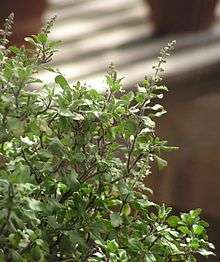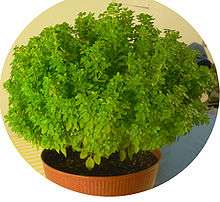List of basil cultivars
Basil cultivars are cultivated varieties of basil. They are used in a variety of ways: as culinary herbs, landscape plants, healing herbs, teas, and worship implements. All true basils are species of the genus Ocimum. The genus is particularly diverse, and includes annuals, non-woody perennials and shrubs native to Africa and other tropical and subtropical regions of the Old and New World.[1] Although it is estimated that there are 50 to 150 species of basil,[2][3] most, but not all, culinary basils are cultivars of O. basilicum, or sweet basil. Some are cultivars of other basil species, and others are hybrids. It is particularly challenging to determine which species a basil belongs to. This is because basil cross-breeds easily, and drawing boundaries between species is particularly difficult. In fact, recent studies have led to reclassification of some portions of the genus.[4]
Basil cultivars vary in several ways. Visually, the size and shape of the leaves varies greatly, from the large lettuce-like leaves of the Mammoth basil and Lettuce leaf basil to the tiny leaves of the Dwarf bush basil. More practically, the fragrance of the basil varies due to the varying types and quantities of essential oils contained in the plants. The most important are 1,8 cineol, linalool, citral, methyl chavicol (estragole), eugenol and methyl cinnamate, although hardly any basil contains all of these in any significant amount.[5]
Basil cultivars




| Ocimum basilicum cultivars | ||
|---|---|---|
| Common name | Species and cultivars | Description |
| Sweet basil | O. basilicum | With a strong clove scent when fresh.[6] |
| Lettuce leaf basil | O. basilicum 'Lettuce Leaf' | Has leaves so large they are sometimes used in salads.[7] |
| Mammoth basil | O. basilicum 'Mammoth' | Another large-leaf variety, stronger flavor than sweet Genovese.[8] |
| Genovese basil | O. basilicum 'Genovese Gigante' | Almost as popular as sweet basil, with similar flavor.[8][9][10][11] |
| Nufar basil | O. basilicum 'Nufar F1' | Variety of Genovese resistant to fusarium wilt. |
| Spicy globe basil | O. basilicum 'Spicy Globe' | Grows in a bush form, very small leaves, strong flavor.[12] |
| Greek Yevani basil | O. basilicum 'Greek Yevani' | Organically grown version of Spicy globe basil. |
| Fino verde basil | O. basilicum piccolo | Small, narrow leaves, sweeter, less pungent smell than larger leaved varieties.[13] |
| Boxwood basil | O. basilicum 'Boxwood' | Grows tightly like boxwood, very small leaves, strong flavor, great for pestos. |
| Purple ruffles basil | O. basilicum 'Purple Ruffles' | Solid purple, rich and spicy and a little more anise-like than the flavor of Genovese Basil. |
| Magical Michael | O. basilicum 'Magical Michael' | Award-winning hybrid with an uncommon degree of uniformity, and nice flavor for culinary use.[14] |
| Dark opal basil | O. basilicum 'Purpurascens' | Award-winning variety, developed at the University of Connecticut in the 1950s.[15] |
| Red rubin basil | O. basilicum 'Red Rubin' | Strong magenta color, similar flavor to sweet basil, also called Opal basil.[8] |
| Osmin purple basil | O. basilicum 'Osmin Purple' | Dark shiny purple with a jagged edge on the leaves, smaller leaves than red rubin.[16] |
| Cuban basil | O. basilicum | Similar to sweet basil, with smaller leaves and stronger flavor, grown from cuttings.[17] |
| Thai basil | O. basilicum var. thyrsiflorum | Called Ho-ra-pa (ต้นโหระพา) in Thai, gets its scent of licorice from estragole.[5] |
| 'Siam Queen' | O. basilicum var. thyrsiflorum 'Siam Queen'[18] | A named cultivar of Thai Basil |
| Cinnamon basil | O. basilicum 'Cinnamon' | Also called Mexican spice basil, with a strong scent of cinnamate, the same chemical as in cinnamon. Has purple flowers.[5] |
| Licorice basil | O. basilicum 'Licorice' | Also known as Anise basil or Persian basil, silvery leaves, spicy licorice smell comes from the same chemical as in anise, anethole. Thai basil is also sometimes called Licorice basil.[19] |
| Mrs. Burns' Lemon | O. basilicum var. citriodora 'Mrs. Burns' Lemon' | Clean, aromatic lemon scent, similar to lemon basil.[18] |
| Ocimum americanum (formerly known as O. canum) cultivars | ||
| Common name | Species and cultivars | Description |
| Lemon basil | O. americanum[18] | Contains citral and limonene, therefore actually does smell very lemony, tastes sweeter. Originally, and sometimes still, called "hoary basil". Popular in Indonesia, where it is known as 'kemangi'. Also sometimes 'Indonesian basil'. |
| Lime basil | O. americanum | Similar to lemon basil.[16] |
| Ocimum ×citriodorum cultivars | ||
| Common name | Species and cultivars | Description |
| Greek column basil | O. ×citriodorum 'Lesbos' | Columnar basil, can only be propagated from cuttings.[20] |
| Thai lemon basil | O. ×citriodorum | Called mangluk (แมงลัก) in Thai. It has a citrus odor, with a distinct Lemon-balm-like flavor[5] |
| Other species and hybrids | ||
| Common name | Species and cultivars | Description |
| Holy basil | O. sanctum (alt. O. tenuiflorum) | Also sacred basil, Tulsi (तुलसी) in Hindi, a perennial breed from India, used in Ayurveda, for worship, and in Thai cooking.[5] |
| Clove Basil | O. gratissimum | |
| Greek basil (Greek spicy globe Basil) | O. minimum (alt. O. basilicum var. minimum) | Forms a nearly perfectly round globe, with thin, tiny leaves and a delicious scent. Despite its name, the variety probably originated in Chile.[21][22] |
| Dwarf bush basil | O. minimum | Unusually small bush variety, similar to Greek bush basil.[6] |
| African blue basil | O. kilimandscharicum × basilicum | A sterile perennial hybrid, with purple coloration on its leaves and containing a strong portion of actual camphor in its scent.[5] |
| Spice basil | O. basilicum × americanum | A fruity/musky-scented cultivar sometimes sold as Holy Basil |
| Sweet Dani basil | O. basilicum × americanum | A vigorous, large-leaved green basil with a strong, fresh lemon scent,[23] a 1998 All-American Selection.[24] |
References
- "Basil: An Herb Society of America Guide". Herb Society of America. Archived from the original on 2006-12-08. Retrieved 2006-12-30.
- Simon, J.E., J. Quinn, and R.G. Murray (1990). "Basil: A source of essential oils". In J. Janick; J.E. Simon (eds.). Advances in new crops. Timber Press, Portland, OR. pp. 484–489.CS1 maint: multiple names: authors list (link)
- The Herb Garden, in the United States National Arboretum, showcases some 25 varieties of basil every year. The Herb Garden was a gift to the United States from the Herb Society of America.
- Paton, Alan, R.M. Harley and M.M. Harley (1999). "Ocimum: an overview of classification and relationships". In Raimo Hiltunen; Yvonne Holm (eds.). Basil: the genus Ocimum. Australia: Harwood Academic Publishers.CS1 maint: multiple names: authors list (link)
- Gernot Katzer. "Basil". Spice Pages. Retrieved 2012-12-03.
- Diane Relf (August 1997). "Basils for the Home Garden". Virginia Cooperative Extension. Archived from the original on 2006-12-05. Retrieved 2006-12-31.
- "Lettuce Leaf Basil". Observations. The Tucson Gardener. Archived from the original on 2010-01-08. Retrieved 2006-12-31.
- "Basil growing: sweet basil". The Tasteful Garden. Archived from the original on July 16, 2011. Retrieved 2006-12-31.
- Miele, Mariangela; Dondero, R; Ciarallo, G; Mazzei, M; et al. (2001). "Methyleugenol in Ocimum basilicum L. Cv. 'Genovese Gigante'". Journal of Agricultural and Food Chemistry. 49 (1): 517–521. doi:10.1021/jf000865w. PMID 11170620.
- Copetta, Andrea; Lingua, G; Berta, G; et al. (2006). "Effects of three AM fungi on growth, distribution of glandular hairs, and essential oil production in Ocimum basilicum L. var. Genovese". Mycorrhiza. 16 (7): 485–494. doi:10.1007/s00572-006-0065-6. PMID 16896796.
- Copetta, A.; et al. (30 November 2006). Three arbuscular mycorrhizal fungi differently affect growth, distribution of glandular trichomes and essential oil composition in Ocimum basilicum var. genovese. 723. ISHS Acta Horticulturae. ISBN 978-90-6605-669-5. Retrieved 3 July 2009.
- "Spicy Globe Basil". iVillage. Archived from the original on 2007-05-19. Retrieved 2006-12-31.
- Deborah Wechsler. "Bountiful Basil". National Gardening Association. Retrieved 2006-12-31.
- "Basil "Magical Michael"". All-American Selections. Colorado State University Denver County Cooperative Extension. Archived from the original on 2006-09-12. Retrieved 2006-12-31.
- "Herbs". Galaxy Gardens. Archived from the original on 2006-11-24. Retrieved 2007-01-05.
- "Basil". Pete's Herbs. Archived from the original on 2007-01-21. Retrieved 2006-12-31.
- Pino, J; Rosado, A; Goire, I; Roncal, E; Garcia, I (1993). "Analysis of the essential oil from cuban basil (Ocimum basilicum L.)". Nahrung. 37 (5): 501–504. doi:10.1002/food.19930370515.
- "Basil-icious!". United States National Herb Garden. Archived from the original on 2007-03-23. Retrieved 2006-12-30.
- "Ocimum basilicum (Anise basil)". Backyard Gardener. Archived from the original on 2007-02-25. Retrieved 2006-12-31.
- "Basil" (PDF). An Herb Society of America Fact Sheet. Herb Society of America. 2003. Archived from the original (PDF) on 2006-12-28. Retrieved 2006-12-31.
- "Basil, Greek or Bush Basil". Chiltern Seeds. Retrieved 2006-12-31.
- http://www.ars-grin.gov/~sbmljw/cgi-bin/taxon.pl?70463%5B%5D
- Thomas DeBaggio (April–May 1998). "Sweet Dani Basil". Herb Companion. Retrieved 2011-06-19.
- "AAS Winners 1933 to Present". All-American Selections. Archived from the original on 2010-02-04. Retrieved 2011-06-19.
General references
- Madalene Hill & Gwen Barclay (2003). "Basil for the Gardener's Kitchen: Herb of the Year, 2003". The Herbarist. 69: 43.
- Helen H. Darrah (1980). The cultivated basils. T. E. Thomas, Buckeye Printing Co. ASIN B0006E2MDS.